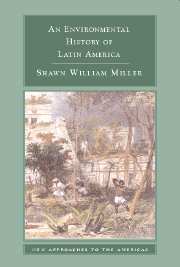Book contents
- Frontmatter
- Contents
- List of illustrations
- Acknowledgments
- Map 1 Middle America
- Map 2 South America
- Introduction: Props and Scenery
- 1 An Old World Before It Was “New”
- 2 Nature's Conquests
- 3 The Colonial Balance Sheet
- 4 Tropical Determinism
- 5 Human Determination
- 6 Asphyxiated Habitats
- 7 Developing Environmentalism
- Epilogue: Cuba's Latest Revolution
- Suggested Further Reading
- Index
7 - Developing Environmentalism
Published online by Cambridge University Press: 05 February 2015
- Frontmatter
- Contents
- List of illustrations
- Acknowledgments
- Map 1 Middle America
- Map 2 South America
- Introduction: Props and Scenery
- 1 An Old World Before It Was “New”
- 2 Nature's Conquests
- 3 The Colonial Balance Sheet
- 4 Tropical Determinism
- 5 Human Determination
- 6 Asphyxiated Habitats
- 7 Developing Environmentalism
- Epilogue: Cuba's Latest Revolution
- Suggested Further Reading
- Index
Summary
This land belongs to the Costa Ricans: many have already died, some are still living, but most are yet to be born.
When Yuri Gagarin successfully entered earth's orbit in 1961, humans, for the first time, caught a god's eye view of the planet they live on. The perspective was novel, but for the next two decades the views were limited to a few cramped astronauts peering through thick portholes, or to satellite cameras spying on Cold War enemies. But that all changed with the launch in 1981 of the space shuttle. Now, scores of humans spent weeks in orbit gazing through picture windows on the world below them. Eyes and handheld cameras were attracted to phenomena that spy and weather satellites had overlooked. Among the more captivating features were human marks on the earth's face, and the most apparent of these was the destruction of the world's largest tropical forest. At night, shuttle crews exposed to film thousands of fires in Rondônia in Brazil's Western Amazon. By day, they measured a pall of smoke that spread over 3 million square kilometers. They also documented the unusual patterns of forest removal that followed the expanding highway networks punched into the forests by states eager to develop their jungle frontiers. In Rondônia, peasant and rancher clearings looked like zippers, roads whose borders were checked with rectangular clearings that extended from narrow frontages.
- Type
- Chapter
- Information
- An Environmental History of Latin America , pp. 193 - 228Publisher: Cambridge University PressPrint publication year: 2007



